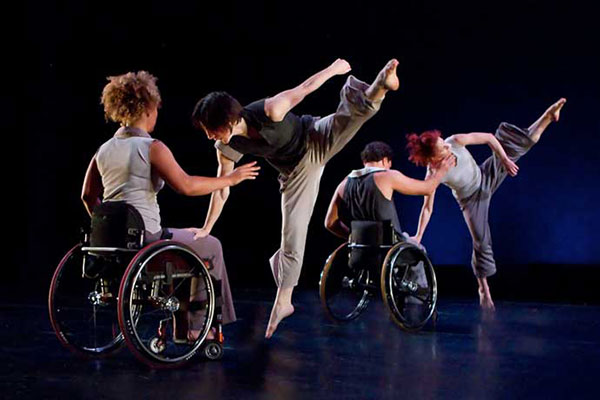AXIS Dance Company, a mixed-ability dance troupe, is in residency with the Mills dance department through Nov. 6. AXIS is based in the Bay Area, where it was started in 1987, and has members with and without disabilities.
In 1997 Judith Smith took over as artistic director and moved the company from mainly in-house choreography to taking on outside choreographers.
“We are providing an extended notion of who can dance and what dance is,” Smith said.
Ann Murphy, the assistant professor of dance and head of the dance department, coordinated this residency with Smith. The two have known each other for 25 years.
AXIS has brought a total of six dancers, including Smith herself, with five principal dancers, a dancer who is given a main role in the dance, to Mills. One of the five principal dancers, Sonsheree Giles, is a Mills Alum who earned her MFA in dance in 2006. According to axisdance.org, Giles joined AXIS in 2005 and has taught contemporary dance in classrooms and festivals across the country.

Sonya Delwaide, the associate professor of dance, has a long history with AXIS Dance Company. In 1998, she became the first outside choreographer they commissioned. Since then, she has choreographed seven pieces for AXIS, including her 2001 piece titled “Suite sans Suite.”

“I look forward to seeing ‘Suite sans Suite,'” Delwaide said, “I look forward to seeing what our students are going to get out of this.”
Each of the AXIS dancers were assigned to take two classes each week: technique, modern, ballet, composition, history of dance, and pedagogy. Members of AXIS will also meet with Delwaide once a week and work closely with her in reconstructing “Suite sans Suite.” This new version of the piece will include Mills students. According to Sebastian Grubb, one of the five principal dancers of AXIS, Mills students have been working on this piece long before AXIS came onto campus. Their presence allowed them to take on leadership roles by teaching the members of AXIS the routine.
“Being around students is already exciting because they already have an eagerness to be exposed to new stuff,” Grubb said.
Incorporating these new members, however, does pose artistic challenges for both the students and Delwaide.
“I’m re-choreographing everything,” Delwaide said. “It’s really revealing. It suddenly took on such different expectations in a way. I like to challenge myself as an artist. How am I going to use these dancers this time?”
“Suite sans Suite” will be shown from Thursday, Nov. 21 at 8 p.m., Friday, Nov. 22 at 1 p.m. and 8 p.m. in Lisser Hall, and Saturday, Nov. 23 at 8 p.m. at the ODC Theatre in San Francisco.
There will be a free public teach-in of Yvonne Rainer’s evolutionary 1966 dance, Trio A on Saturday, Nov. 2nd. This event will be led by Linda K. Johnson, who is one of only five repetiteurs approved by Rainer to teach this dance.
“Trio A is an anti-dance dance that through seemingly ordinary movement challenges the long-held aesthetic assumptions about the dancer and the content of a dance, and the dancer’s relationship to her audience,” Murphy said.
On Monday, Nov. 4 at 4 p.m., AXIS will be hosting a community dance workshop that will be open to the entire Mills community. They will be talking more closely about their company and will also teach attendees how to move in the space that they are in.
“Dancers have to physically negotiate the space with a person who has an apparatus,” Murphy said.
According to Murphy, the goal of these workshops is to redefine dance. They are making it so that even those with physical disabilities can not only dance, but utilize those disabilities to enhance their performances.
“I’m excited about what I already see happening with the students,” Murphy said, “It is so remarkable to watch such complexity and such simplicity occur at the same time. I can tell all of the dancers were entranced.”

